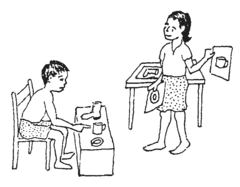Hesperian Health Guides
Let’s Find Out How Well Children See and Hear
HealthWiki > Disabled Village Children > Chapter 47: Helping Teachers and Children > Let’s Find Out How Well Children See and Hear
Contents
- 1 Background discussion
- 1.1 HELPING CHILDREN UNDERSTAND THE PROBLEM
- 1.2 Games to help children understand the difficulties of hearing loss
- 1.3 Games to help children understand the difficulties of vision loss
- 1.4 FINDING OUT WHICH CHILDREN HAVE DIFFICULTY WITH HEARING AND SEEING
- 1.5 Testing the hearing of babies (4 months old and older)
- 1.6 Testing the hearing of young children (a game)
- 1.7 What to do for the child with hearing loss
- 1.8 HOW CAN CHILDREN HELP CARE FOR THEIR FAMILY MEMBERS' EARS?
- 1.9 HEARING GAMES THAT CHILDREN CAN PLAY WITH BABIES
- 1.10 Testing if a baby sees (for a child over 3 months old)
- 1.11 Testing how well children see (4 years old and older)
- 1.12 WHAT TO DO FOR THE CHILD WITH VISION LOSS
- 1.13 Looking at each other’s eyes for signs of problems
Background discussion
Some children cannot see or hear as well as other children. Often we do not know about this and the child says nothing. But because the child does not hear the teacher or see the blackboard, he may not learn as quickly as others. So he may try to hide in a corner. We can help him by letting him sit close to the teacher.
Also, babies who cannot hear well do not learn to talk or understand as early as others.
In this activity, the school children try to find out which young children and babies do not see or hear well, and need help.
HELPING CHILDREN UNDERSTAND THE PROBLEM
One way to get children thinking about these problems is to ask questions like:
- Do you know anybody who does not see or hear well?
- Do you act differently with these people? Why?
- How would you feel if you did not see well? Or hear well?
Games to help children understand the difficulties of hearing loss

GAME: LISTEN LISTEN
All the children are completely silent for 3 minutes. They listen very carefully to the noises around them. Afterwards, they write down or draw everything they heard.
GAME: WHAT DID YOU SAY?
One child plugs his ears while another tells a funny story to the group. Then one of the children plays “teacher” and asks everyone, including the child who had his ears plugged, to answer questions about the story. Finally, they ask him what it felt like, not being able to hear the story well.
Ask the children what they can do to help a child to hear better. Their suggestions might include:
- Have the child sit “up front” close to the teacher.
- Everyone can take care to speak slowly, clearly, and loudly (but do not shout).
- Use gestures or sign language (if the child hears very little or not at all).
- Watch people’s mouths and try to understand what they say. This is not easy if you do not hear the words. Have the children try it.
GAME: TALKING WITHOUT WORDS

Some children with hearing loss cannot speak. This is because they need to be able to hear in order to learn how to speak. This game will help children appreciate the difficulties of a child who cannot speak, and give the children ideas of how to communicate without words to a child who does not hear.
Play a game where someone explains something to others through acting only, without words. The others must guess what it is he is trying to say. The leader can start by acting out a simple phrase like: “I want a glass of water.” The children try to guess what the leader is doing. Next have the children take turns acting out different things and ideas. Start with easy phrases like:

- I want to go to sleep.
- Give me the ball.
And work toward more difficult ideas like:
- I’m lost and can’t find my house.
- I had a bad dream.
Discussion after the game:
- Was it difficult to explain something without talking?
- How did you feel when no one understood you?
- What did the other children do to help you tell them what you wanted to?
- Could they have done more? What?
- How might you help children who cannot speak to communicate?
Explain to the children about sign language for people with hearing loss. This is like the game in which children “talk” with their hands. One form of sign language uses mostly the alphabet. Another form, which people with hearing loss prefer, uses symbols for different actions and things.

If there is a child with hearing loss in the school, or in the village or neighborhood, perhaps the children would be interested in finding a way to help that child learn to sign. Or they may want to learn themselves, in order to be able to communicate with the deaf child.
If 1 or 2 children in the class can learn to sign and then help translate spoken language into sign language, this can allow the children with hearing loss to learn and take part more fully in the school and in the community. (See books to learn sign language.) Also see Chapter 31.
Games to help children understand the difficulties of vision loss
GAME: CATCH A THIEF

This game can help children understand both the difficulties of hearing and vision loss.
- The children form a circle. One child stands in the middle with her eyes covered. Around her feet are small stones, nuts, or other small objects.
- The other children, one by one, try to creep up and steal these things.
- If the child in the middle hears the “thief,” she points to him and he is out of the game.
- The goal is to see who can steal the most objects without being heard.
GAME: BLURRED VISION
One or more children are temporarily given blurred vision in one of several ways:

thick lenses |
 |
| Or, cover his eyes with a piece of tracing paper, wax paper, or other material that you can see through slightly. | Put somebody's powerful eyeglasses on a child who needs no glasses. |
Have the child try to read from a book with letters of different sizes. Do the same on the blackboard. What trouble does he have? How close does he have to get? Does he read aloud from his book as well as the other children?


GAME: BLINDFOLDED PARTNERS
The children are in pairs. One is blindfolded, the other is her guide. The guide takes the blindfolded person for a walk, letting her feel different things and taking care of her.
After the game, discuss:
- How did it feel not to be able to see?
- What did your guide do that was helpful? Not helpful? What might she have done better?
- Did you trust your guide?
GAME: FEEL A FRIEND

One child is blindfolded. He tries to recognize his friends by feeling them.
Similar feeling games can be played trying to identify different things by feeling them.
GAME: WHAT’S THE SMELL?

Blindfold the children and have them identify things by their smell: things such as orange, tea leaves, banana, and local herbs.
After the children play these different games, explain to them that because people with loss of vision cannot see, they often develop outstanding ability to identify things through hearing them, feeling them, and smelling them.
FINDING OUT WHICH CHILDREN HAVE DIFFICULTY WITH HEARING AND SEEING
It is important to find out as early as possible if a child cannot hear or see well. Older children can do some simple tests with their younger family members. A class or group of children can also test the seeing and hearing of younger children, such as those in nursery school or the first year of elementary school.
Testing the hearing of babies (4 months old and older)

- Children can notice if their baby sister responds to different sounds, high and low, loud and soft. The baby may show surprise, make some movement, or turn her eyes or head toward the sound. Notice if the baby responds to her mother’s voice when the baby does not see her.
- Or make a rattle from seeds or small stones. Creep up and shake it behind the baby’s head, first on one side and then the other. See if the baby is surprised.

- Then call the baby’s name from different places in the room. See if the baby responds.
- To test if a baby hears some kinds of sound but not others, do this. Sit at arm’s length from the baby, and to one side. When she is not looking, make different kinds of sounds. Say “Ps” and “Fth” to test for highpitched sounds, then “Oooo” for low-pitched sounds. For other high pitched sounds, crinkle a thin, stiff piece of paper or rub a spoon inside a cup. For other low pitched sounds, watch if the child notices the noise of a passing truck, a train whistle, a cow’s “moo” or low notes on a musical instrument or drum.
If the baby does not follow the object or light with his eyes or head, probably he does not see. He will need help learning to do things and move about without seeing. Other children can help (see Chapter 31.)
Testing the hearing of young children (a game)
- An older child stands several meters from a line of younger children.
- Behind each young child stands an older child with pencil and paper

- The first child says the name of an animal VERY LOUDLY
- The young children whisper the word to their older partners.
- The older children write it down.
- Then the first child names other animals, each in a softer and softer voice, until he is whispering.
- After about 10 animals have been named, and the words that the younger children heard have been written down, compare the different children’s lists.
- Repeat this 2 or 3 times
- Any child who has not heard as many words as the others, or has not heard them correctly, may have hearing loss.
What to do for the child with hearing loss
- Let the child sit at the front of the class where he can hear better.
- Be sure everyone speaks clearly and loudly enough. But do not shout because shouting makes the words less clear. Check often to make sure the child understands.
- Have one child who hears well sit next to the child with hearing loss—to repeat and explain things if necessary.
- Always try to look at the child while you are speaking to him.
- If possible, the child should be examined by a health worker—especially if he has pus in an ear or frequent earache.

HOW CAN CHILDREN HELP CARE FOR THEIR FAMILY MEMBERS' EARS?
They can regularly look to be sure that there is no pus or small objects inside. If they see anything wrong they should tell an older person, who should take the child to a health worker.
HEARING GAMES THAT CHILDREN CAN PLAY WITH BABIES
Most babies with hearing loss hear something. They need help in learning to listen. The children may think of games to help babies listen and learn.

For example:
- Sing to babies, and teach songs to young children.
- Tell them stories and change voices to sound like different people in the story—loud, soft, angry.
Testing if a baby sees (for a child over 3 months old)

- Children can notice if the baby begins to look at things held in front of him, to follow them with his eyes, to smile at mother’s face, and later to reach for things held out to him.
- Hang a bright colored object in front of the baby’s face and move it from side to side. Does the baby follow with his eyes or head?
- If not, in a fairly dark room, move a lighted candle or torch (flashlight) in front of the child’s face. Repeat 2 or 3 times.
If the baby does not follow the object or light with his eyes or head, probably he does not see. He will need special help in learning to do things and move about without seeing. Other children can help. (See Chapter 30.)
Testing how well children see (4 years old and older)
A group of older children can make an eye chart. They can cut out black “E”s of different sizes and paste them on white cardboard.



 |
 |
 |
First let the children test each other, one eye at a time. Hang the chart in a place where the light is good. Then make a line about 3 meters from the chart. The child to be tested stands behind the line, holding the cut-out “E” and covering one eye. Another child points at the different “E” shapes, starting from the top.
Ask the child being tested to hold the cut-out “E” so that its legs point the same way as the “E” on the chart. When he gets to the bottom, or can no longer see, have him cover the other eye and start over. If the child can easily see the “E”s on the bottom line, he sees well. If he has trouble seeing the second or third line, he has vision difficulty.
- To make the testing more fun, you can use horses in the shape of “E”s.
- Make 5 cards using different size horses. Make the sizes the same as those shown for the letter “E” in the chart at the top of this page.
- Or use a chart with “C”s. Ask the child either to hold a horse shoe in the same position as the different “C”s on the chart, or to tell you for each “C” which way the horse shoe is going.
To test children with cognitive delay, hearing loss, or who have trouble communicating, you can use pictures of different things they recognize. Hold up one picture at a time and have the child either name it or point to a similar picture-or the real object. For example, you can make a set of cards with pictures like this:


After the children practice testing each other, they can test the eyesight of those in the younger grades and the children who will be starting school soon.
Looking at each other’s eyes for signs of problems

Start with questions to get the children interested. For example:
- Are your eyes the same as your classmates? Shiny? Clear?
- How about the eyes of your younger family members?
- Can you see well in the dark? Or do you often stumble at night?
- Do a child’s eyes look dull? Are there any unusual spots or wrinkles? If so, see a health worker.
Many children in different parts of the world lose their vision because they do not get foods that make their eyes healthy. Eating yellow fruits or dark green leafy vegetables helps protect the eyes. Some extra cooking oil added to food also helps.

If children’s eyes are red or sore, you can suggest that they wash them often with clean water with a little salt in it (no saltier than tears). This may help eyes get better and also keeps harmful flies away from eyes. If they do not get better soon, see a health worker
For more information on eye problems and loss of vision, see Chapter 30.



